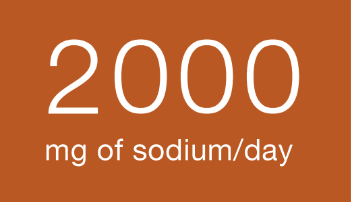Dietary Recommendations
2000 mg Sodium Diet
Sodium is a mineral essential for the proper regulation of body fluids, nerve and muscle function. Most healthy people require only about 500 milligrams of sodium per day to maintain sodium balance. Typically, Americans consume on average approximately 4,000-8,000 milligrams per day. Sodium is present naturally in many of the foods we consume in our diet.
- Only 15% of sodium intake by Americans is from table salt.
- 75% of sodium intake is from processed or prepared foods.
Excess sodium intake has been linked with high blood pressure and exacerbation of heart failure symptoms. Consumption of foods high in sodium can cause water retention in the lungs, abdomen, and lower extremities.
Reading Food Labels: Sodium
Sodium claims and what they mean:
- “Sodium Free” = Less than 5 mg per serving
- “Very Low Sodium” = 35 mg or less per serving
- “Low Sodium” = Less than 140 mg per serving
- “Reduced or Light Sodium” = 25-50% less sodium per serving than the regular version of the same product, but it still may be high in sodium.
High sodium foods to avoid:
- Canned soups, sauces, liquid Bouillon and Bouillon cubes (e.g. soy sauce, teriyaki sauce, marinara sauce, steak sauce, chili sauce)
- Packaged convenience foods (e.g. Mac n’ Cheese® and Instant Noodles)
- Pickled foods (e.g. pickles, olives)
- All cured or smoked foods
- Processed foods (e.g. hot dogs, luncheon meats, bacon, sausage, ham)
- Baking soda
- Pancake mix
- Salted snack foods
- All sports drinks (e.g.Gatorade®, Powerade®)
- Regular tomato juice/V8 juice
These tips can help you choose which foods to buy:
- Look for products with 100-200 mg of sodium per serving
- Avoid foods with more than 400 mg of sodium per serving
- Frozen dinners are okay up to 600 mg.
- Compare brands and choose the ones with less sodium.
Eating Out, Eating Smart
Everyone loves to eat out. Heart Failure is not a reason to stop dining out. Follow these guidelines:
- Avoid fast foods and most restaurant foods (e.g. Chinese, Mexican, Italian)
- Call a restaurant ahead of time to determine if they have food that is not pre-seasoned
- Special order your meal with “No Added Salt”
- Bring your own seasonings
- Control portion size – order gravy and dressings “on the side”
- Request fresh fruit, sherbert, or sorbet for dessert
- Choose salad over soup
- Choose baked potatoes over mashed potatoes (which is usually already seasoned)
- DON’T cheat!
- Look up nutritional information online or on phone application to find out sodium content in advance
Helpful Tips for Reducing Sodium Intake
- Shake the salt habit: Get rid of the saltshaker! Do Not Add Salt to table food (table salt is about 40% sodium)
- Omit salt in recipes. Do not add salt before, during, or after cooking.
- Shop and keep foods that you CAN have instead of focusing on foods that you cannot eat
- Use fresh herbs, spices, vinegar or lemon juice to flavor food
- Use fresh fish, poultry and meat
- Read food labels
This is a no added salt diet:

Ignore % on the label. Count mg of sodium instead.

